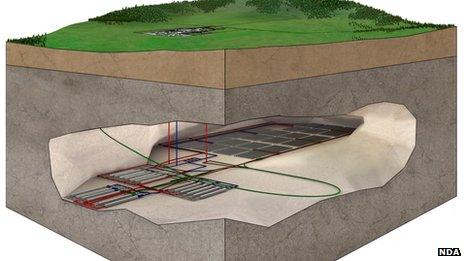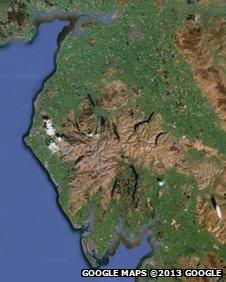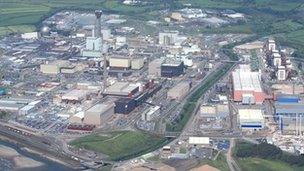Cumbria nuclear waste dump: What were councils considering?
- Published

Radioactive waste contained in canisters would be buried beneath Cumbria
Britain needs to find a site for the long-term underground disposal of high-level radioactive waste.
With some of it staying dangerous for up to 100,000 years, the government's agreed solution is to bury it - permanently.
Three Cumbria councils were voting on Wednesday on whether to proceed to the next stage in the process of investigating whether such a facility would be possible - and safe - in the county.
Although Copeland Borough Council voted in favour, Cumbria County Council ruled out Allerdale Borough and then also vetoed a move to this "Stage 4" for Copeland Borough.
What does the government want to build?
Any underground storage facility would be up to four times the size of Sellafield - between 6 sq km and 23 sq km (2.5 and 9 sq miles).
At its smallest, it would be about the size of Workington or Whitehaven; at its biggest, larger than Carlisle.
However above ground the footprint would be about 1 sq km (0.4 sq miles).
Waste would be stored in underground vaults at a depth of between 200m (656ft) and 1,000m (3,280ft) and there would be some buildings on the surface.
The Department of Energy and Climate Change said that over the 100-year lifetime of the £12bn facility an average of 550 workers would be employed on construction.
This would peak at 1,000 workers in the busiest times.
Currently, radioactive waste is stored above ground in various "long-term temporary" sites around the UK, mostly at Sellafield.
In its final report, the West Cumbria Managing Radioactive Waste Safely (MRWS) Partnership - set up to coordinate discussions - said there could be "positive and negative impacts".
Concerns include the noise and traffic caused by construction and possible effects on landscape, tourism, investment and jobs, the report said.
But the partnership said: "Our overall opinion is that, at this stage, we are fairly confident that an acceptable process can be put in place to assess and mitigate negative impacts, and maximise positive impacts."
Benefits and positive opinion
The waste needs to go somewhere and Cumbria was the only area still considering an underground storage facility.
Dungeness in Kent, who had initially shown interest, withdrew at the end of 2012 in the face of opposition from residents.
The government, keen to attract volunteers, rather than impose the proposal on an unwilling area, had promised certain benefits, such as money for transport, public service infrastructure and housing, for any council which agreed to accept the storage facility.
Advocates of the plans say it would have protected, and created, nuclear industry jobs, with more than 9,000 people already working at Sellafield.
Jamie Reed, Labour MP for Copeland, which encompasses the plant, said: "Cumbria stands to benefit hugely, in a genuinely unprecedented fashion, should a Geological Disposal Facility (GDF) ever be sited here."
He stressed the "investment package" must be suitable, the final decision must "rest with a local referendum not politicians" and unsuitable geology would put paid to the whole scheme.
Lynn Berger, who runs the Woolpack Inn near Boot in the Eskdale Valley, is more concerned about the effect of "scaremongering" on tourism than the facility itself.
"It's not going to make any difference to us from a radiation point of view," she said.
"And, if anything, everything is so much more controlled because it [Sellafield] is there. The house isn't going to fall down, we're not going to bash a hole in the cellar wall and find the beer turns green."
John Rowlands, of Romar Innovate in Whitehaven, is also positive: "We've had waste stores at Sellafield before and it hasn't affected the industry.
"The nuclear industry has worked alongside tourism for as long as I can remember."
Arguments against
There are concerns about safety and, particularly, the perception of safety among tourists and investors.
Critics are also concerned about visual damage to the landscape and the effect on farming.
Some point out any research is pointlessly going over old ground, citing a plan by Nirex, external, the agency then responsible for the disposal of nuclear waste, to build an underground waste laboratory in the 1990s which was scrapped after a planning inspector ruled the area's geology made it unsafe.

Geologists disagree over which parts of Cumbria might be suitable
Former Nirex inspector, Chris McDonald, has said he was "very surprised" West Cumbria was again being suggested as a potential site and "the probability of their finding a suitable site is low".
The Lake District National Park Authority has already told the government that a repository "would not be in the long-term interests of the Lake District" and would risk the area's "brand image".
Its chairman, Bill Jefferson, has said the effects on the landscape and tourism could be disastrous and that tourism brings more income to the area than the nuclear industry.
Campaigner Harry Marsland, from Keswick, has said a "nuclear dump will do significant damage" to the area's image.
"In Cumbria tourism is worth £2bn per annum, and employs 56,000 people directly, plus it provides the work for countless trades people, suppliers and retailers. Let's be clear, it depends upon the Lake District," he said.
What next?
Cumbria County Council, Copeland Borough Council and Allerdale Borough Council had to decide whether to move to the next stage of a process that is still decades away from completion, even if it had been approved.
They had sought further assurances from the government, including clarification on when, exactly, they could legally withdraw from the process should they want to.

Sellafield already stores a large amount of radioactive waste earmarked for disposal
"Stage 4" would have involved undertaking vast geological investigations, properly testing theories for and against, and holding formal talks with the government over any "community benefits package".
Unsuitable sites would have been ruled out and, if any remained, further tests will be carried out, including seismic surveys.
If any site had ultimately been deemed acceptable construction could have started as soon as 2025.
- Published30 January 2013
- Published28 January 2013
- Published12 January 2013
- Published8 October 2012
- Published8 October 2012
- Published20 July 2012
- Published22 May 2012
- Published23 March 2012